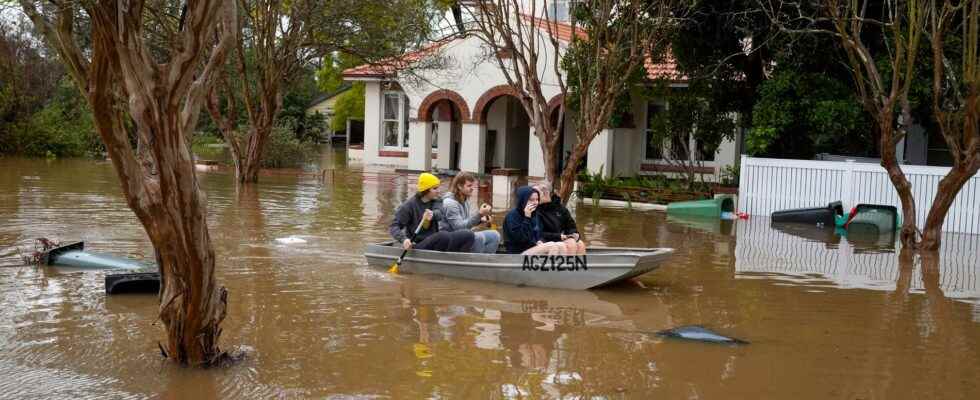Published: Less than 20 minutes ago
1 of 5Photo: Mark Baker / AP / TT
For the second time in just a few months, entire communities in south-eastern Australia are under water.
– The people here just feel hopeless, says environmental researcher Ian Wright.
According to Wright, the lack of infrastructure and the rapid growth in parts of the country are contributing to the devastating consequences of the floods.
Southeast Australia has been hit by heavy rainfall since last week and parts of the state of New South Wales have been flooded. Again.
– Many were just repairing their homes after the previous flood. They were first affected in March last year, then in March this year. It was only 16 weeks since last, says Ian Wright resigned.
Wright is an environmental researcher specializing in water issues and works at the Western Sydney University campus in Hawkesbury, about 70 km northwest of the city of Sydney. One of the areas that has been worst affected by the storms.
Like a bathtub
The water levels in the Hawkesbury River have been recorded for over 220 years, the British came to the area in the 1790s, and the latest flood is the tenth worst that has been measured during that time, Wright says. The valley around the Hawkesbury and Napean rivers is usually described as a bathtub – a wide and flat landscape which, when the water levels in the rivers rise quickly, can be hit by severe floods.
– Once there is a flood, it fills up quickly and becomes like a big lake, says Ian Wright.
And now the area is flooded again. Just like it was in March this year. And in March last year.
Prior to that, the last major flood occurred in 1990.
– We had 31 years without major floods. The knowledge (about floods) disappears from the general consciousness. It is said “yes it is a river plain, but it is calm the river is not flooded anymore”.
Insufficient infrastructure
Climate change is seen as one of the reasons why floods occur more often. Warmer air binds more liquid so the higher temperature leads to more extreme weather, states Ian Wright.
– Climate change is a reality and will have an impact. But Hawkesbury also has an irregular pattern and it was extremely fortunate that we avoided floods for 31 years. In the same way, there were no serious floods between 1904 and 1956, he says.
Hawkesbury-Napean is part of one of the areas around Sydney that the state of New South Wales has invested in recent years to meet a rapidly growing metropolitan area. But Ian Wright believes that the communities around the rivers are not adapted to the risks. It has been built at a much faster pace than the infrastructure can handle.
– You should not have given permission for so many constructions, he says.
The roads, in many places single-lane and often poorly maintained, in an area where you are completely dependent on the car are under normal conditions insufficient, Wright says.
– The infrastructure is a prerequisite for us to be able to live here in harmony with nature, he says.
Now, during the downpours, or as a few years ago when extensive forest fires ravaged, the roads are not only inadequate but the lack of infrastructure poses a danger to life, says Wright.
– We need better, wider roads and higher bridges to be able to get out of here quickly when the water rises.
Mold big problem
Ian Wright is really worried about how the flood-affected residents will cope this time. Many also lack flood insurance because it is simply too expensive.
About 20 people died in the floods in News South Wales and neighboring Queensland in March this year. The recent flood has so far not been as deadly.
But a problem now is that it is winter in Australia and relatively cold. The last two floods occurred in March, when it is hot outside. Now with colder temperatures, homes and property are not drying up properly.
– Mold is a big problem. It can cause many respiratory problems and there are also many cases of flu and covid now. I’m really worried that so many flood victims also have respiratory problems. And accumulated stress over everything that happens, it also hits the immune system. I think we’ve just lost one life in this flood, but I would not be surprised if we lose many more in the long run.
Facts
Heavy rains and floods in south-eastern Australia
Heavy torrential rains have hit eastern Australia since the weekend, with floods as a result.
The rescue service in the state of News South Wales only pulled out almost 400 times on Monday to rescue flood victims.
On Wednesday, about 85,000 people in the state were ordered to leave their homes, or be prepared to do so. Tens of thousands of households are or have been without electricity in recent days.
According to the weather authority BOM, parts of the southern Sydney area received more than 23 centimeters of rain in 24 hours earlier this week – this corresponds to more than 17 percent of the annual average in the state of New South Wales.
Read more
